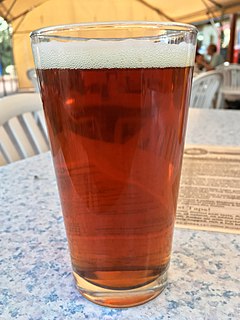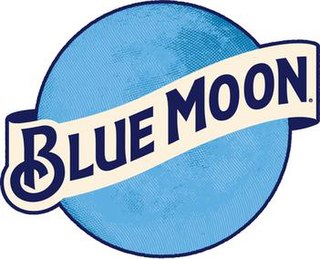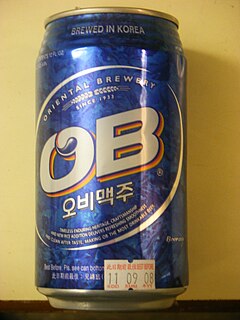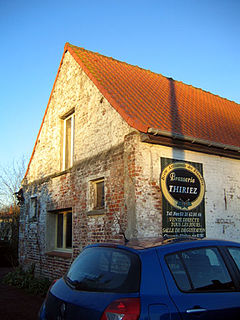Adnams is a regional brewery founded in 1872 in Southwold, Suffolk, England, by George and Ernest Adnams. It produces cask ale and pasteurised bottled beers. Annual production is around 85,000 barrels.

Pale ale is an English style ale made with pale malt. The term first appeared around 1703 for beers made from malts dried with high-carbon coke, which resulted in a lighter colour than other beers popular at that time. Different brewing practices and hop quantities have resulted in a range of tastes and strengths within the pale ale family.

Trappist beer is brewed by Trappist monks. Fourteen monasteries—six in Belgium, two in the Netherlands, and one each in Austria, Italy, England, France, Spain and the United States—currently produce Trappist beer as members of the International Trappist Association (ITA). However, the Authentic Trappist Product label is assigned by the ITA to the beer products of just eleven breweries which meet their strict criteria. As of 2021, Achel is no longer recognized as a Trappist brewery because it does not have any living monks.

Unibroue is a brewery in Chambly, Quebec, Canada, that was started by Serge Racine and Quebec native André Dion. The company was purchased by Sleeman Breweries Ltd. in 2004, which was itself taken over by Sapporo in 2006. The company was incorporated in 1993 and is the first of three microbrewing companies in Greater Montreal area, both chronologically and in terms of sale benefits.

Duvel Moortgat Brewery is a Flemish family-controlled brewery founded in 1871 in the Antwerp Province (Belgium). Its strong golden pale ale, Duvel, is exported to more than forty countries. Duvel is Brabantian, Ghent and Antwerp dialect for devil, the standard Dutch word being duivel[ˈdœy̯vəl]. Other popular beers include Maredsous and Vedett.

Chimay Brewery is a brewery at Scourmont Abbey, a Trappist monastery in Chimay, Hainaut, Belgium, one of the thirteen breweries worldwide that produce Trappist beer. They make four ales: Chimay Rouge, Chimay Bleue, Chimay Blanche, and new Chimay 150; and one patersbier for the monks. The monastery also makes four varieties of cheese.

Westmalle Brewery is a Trappist brewery in the Westmalle Abbey, Belgium. It produces three beers, designated as Trappist beer by the International Trappist Association. Westmalle Tripel is credited with being the first golden strong pale ale to use the term Tripel.

Beer in Belgium varies from pale lager to amber ales, lambic beers, Flemish red ales, sour brown ales, strong ales and stouts. In 2018, there were approximately 304 active breweries in Belgium, including international companies, such as AB InBev, and traditional breweries including Trappist monasteries. On average, Belgians drink 68 liters of beer each year, down from around 200 each year in 1900. Most beers are bought or served in bottles, rather than cans, and almost every beer has its own branded, sometimes uniquely shaped, glass. In 2016, UNESCO inscribed Belgian beer culture on their list of the intangible cultural heritage of humanity.

Blue Moon Belgian White is a Belgian-style witbier brewed by MillerCoors under the name the Blue Moon Brewing Co. It was launched in 1995, and was originally brewed in Golden, Colorado.

Oriental Brewery or OB is a South Korean brewery currently owned by AB InBev, and initially founded by Doosan Group.

Fantôme is a small brewery in Soy, Wallonia, Belgium. Founded in 1988 by Dany Prignon, it produces saisons, a type of farmhouse ale.
Heineken N.V. is a Dutch brewer which owns a worldwide portfolio of over 170 beer brands, mainly pale lager, though some other beer styles are produced. As of 2006, Heineken owns over 125 breweries in more than 70 countries and employs approximately 57,557 people.
Dupont Brewery is a brewery in Tourpes (Leuze-en-Hainaut), in western Hainaut, Belgium. Founded in 1950, it is on a working farm which dates back to 1759 and has significant brewing history. In the 1990s, a bread bakery and cheese-making facility were added.

The Malt Shovel Brewery is an Australian brewery owned by Lion, which in turn is a subsidiary of the Japanese conglomerate Kirin. It is located in Camperdown, New South Wales. Malt Shovel is best known for its James Squire range of beers. The beer is named after the convict turned Australia's first brewer James Squire, who also went on to grow Australia's first hops and is said to have created Australia's first commercial brewery.

The beers of the Caribbean are unique to each island in the region, although many are variants of the same style. Each island generally brews its own unique pale lager, the occasional stout, and often a non-alcoholic malta beverage. Contract-brewing of international beers is also common, with Heineken Pilsener and Guinness Foreign Extra Stout being the most popular. The beers vary between the islands to suit the taste and the brewing method used.

Brasserie Thiriez is a small craft brewery located in Esquelbecq, a town in the Arrondissement of Dunkirk in the Nord département, in the Nord-Pas-de-Calais région of France, quite close to the Belgian border. It is situated on the grounds that formerly housed the Poitevin farm brewery, which was active and served the local area until 1945. The current brewery was founded in 1996 by Daniel Thiriez, who had become interested in homebrewing as a college student, and later left his career as a "human resources professional for a large supermarket chain" in the interest of reviving the tradition of the small village brewery. It exports beers in Europe, and the USA.
Brasserie de Brunehaut is the trade name for Brunehaut Brewery, located in Rongy-Brunehaut (Hainaut), Wallonia, 80 km south/southwest of Brussels, Belgium, near the French border.

Tripel is a term used by brewers mainly in the Low Countries, some other European countries, and the U.S. to describe a strong pale ale, loosely in the style of Westmalle Tripel. The origin of the term is unknown, though the main theory is that it indicates strength in some way. It was used in 1956 by the Trappist brewery, Westmalle, to rename the strongest beer in their range, though both the term Tripel and the style of beer associated with the name, were in existence before 1956. The style of Westmalle's Tripel and the name was widely copied by the breweries of Belgium, and in 1987 another Trappist brewery, the Koningshoeven in the Netherlands, expanded their range with a beer called La Trappe Tripel, though they also produced a stronger beer they termed La Trappe Quadrupel. The term spread to the U.S. and other countries, and is applied by a range of secular brewers to a strong pale ale in the style of Westmalle Tripel.

Beer has been produced in Scotland for about 5,000 years. The Celtic tradition of using bittering herbs remained in Scotland longer than in the rest of Europe. Most breweries developed in the central Lowlands, which also contained the main centres of population. Edinburgh and Alloa in particular became noted centres for the export of beer around the world. By the end of the 20th century, small breweries had sprung up all over Scotland.

Most beer sold in France is pilsner lager, mass-produced by major breweries which control over 90% of the market, although there are also traditional beer styles, such as top-fermented Bière de Garde, and a number of microbreweries.
















